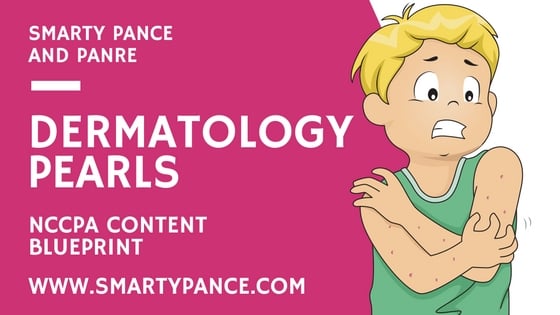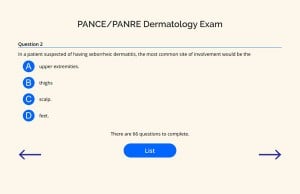Dermatology PANCE and PANRE Blueprint PEARLS
- This is a comprehensive list following the exact NCCPA PANCE and PANRE Dermatology content blueprint
- The dermatology section represents 5% of your PANCE and PANRE board exam
- Make sure to download my FREE content blueprint checklist
- Members have access to the comprehensive 66-question dermatology exam
- Dermatology Pearls Flashcards
- Dermatology Pearls high yield summary tables
- ReelDX™ integrated video content
PANCE and PANRE Dermatology Pearls
Eczematous Eruptions (PEARLS) |
|
| Dermatitis | Pruritic, red-purplish, scaly patches and plaques with some fissures and erosions involving chiefly the hands, especially the dorsal surface of the fingers and also the feet with few lesions on the trunk of two months duration. |
| Dyshidrosis | Characterized by a pruritic vesicular eruption comprised of clear, deep-seated vesicles without erythema erupting on the lateral aspects of fingers, the central palm, and plantar surfaces. The eruption has been described as resembling tapioca pudding. The onset may be acute, recurrent, or chronic. |
| Lichen simplex chronicus | Lichen simplex chronicus (LSC) is a chronic dermatitis resulting from chronic, repeated rubbing or scratching of the skin. Skin becomes thickened with accentuated lines (“lichenification”). The constant scratching causes thick, leathery, brownish skin. |
Papulosquamous Diseases (PEARLS) |
|
| Drug eruptions | An adverse cutaneous reaction in response to administration of a drug. Skin reactions are the most common adverse drug reactions. Severity can range from mild eruptions that resolve after the removal of the inciting agent to severe skin damage with multiorgan involvement. |
| Lichen planus | Lichen planus (LP) is a chronic papulosquamous inflammatory dermatosis of unknown etiology, probably autoimmune in origin, clinically characterized by 5Ps (pruritic, purplish, polygonal, plain-topped papules). |
| Pityriasis rosea | Pityriasis rosea typically occurs in children and young adults. It is characterized by an initial herald patch, followed by the development of a diffuse papulosquamous rash. Pityriasis rosea is easier to identify when the general eruption appears with smaller secondary lesions that follow Langer’s lines (cleavage lines) in a “Christmas treelike pattern.”
Many diseases can mimic pityriasis rosea, including drug exanthems, but the most worrisome condition to be ruled out is secondary syphilis. Topical or systemic steroids and antihistamines are often used to relieve itching. Asymptomatic lesions do not require treatment. |
| Psoriasis | The classic clinical appearance is a well-demarcated, erythematous, silvery scaly plaque
Patients may also present with no rash and only joint symptoms - pain in both hands and nail changes such as pitting and onycholysis |
Desquamation (PEARLS) |
|
| Erythema multiforme | Skin lesions include raised typical target or “iris” lesions or raised atypical lesions predominantly involving the extremities. Target-like shape, blanching, and lack of itchiness help characterize this rash! |
| Stevens-Johnson syndrome | SJS is a drug reaction. Layers of skin peel away in sheets (+) Nikolsky's sign and commonly caused by anticonvulsants and sulfa drugs! |
| Toxic epidermal necrolysis | Very similar to Steven-Johnson syndrome – The difference is the age of the individuals (in TEN older patients vs. SJS younger patients) and percentage of the body affected (in TEN > 30% of body surface area affected vs. SJS < 10% of body surface area affected). |
Vesicular Bullae (PEARLS) |
|
| Bullous pemphigoid | Chronic acquired autoimmune subepidermal blistering skin disorder caused by linear deposition of autoantibodies against the epithelial basal membrane zone: IgG produced against the basement membrane.
Diagnosis is made by skin biopsy with direct immunofluorescence exam shows deposition of IgG and C3 basement membrane, treated with corticosteroids (topical or oral) |
Acneiform Lesions (PEARLS) |
|
| Acne vulgaris (ReelDx) | Differentiate by the presence of comedones - open comedones (blackheads) incomplete blockage and closed comedones (whiteheads) complete blockage. Isotretinoin is highly teratogenic and may cause psych side effects, hepatitis, and increased triglycerides/cholesterol. Must obtain 2 pregnancy tests prior to starting it and monthly while on it!
|
| Rosacea | Differentiate from acne by lack of comedones (blackheads), treated with topical metronidazole, may cause rhinophyma (big nose), forehead, cheeks, and nose, associated with telangiectasia |
Verrucous Lesions (PEARLS) |
|
| Actinic keratosis | Occurs on sun-exposed surfaces and is a precursor to squamous cell carcinoma, treat with cryotherapy, 5 FU cream |
| Seborrheic keratosis | Most common benign skin tumor seen in fair-skinned elderly patients with prolonged sun exposure, Waxy, “Stuck on” appearance, commonly referred to “Barnacles of old age”, no treatment is necessary |
Insects/Parasites (PEARLS) |
|
| Lice | Body (corporis); Pubic (pubis), launder potential fomites such as sheets in hot water (> 131 F or 55 C)
Permethrin topical is the drug of choice:
|
| Scabies | Lesions in web spaces of hands, wrists, waist with severe itching (worse at night), treated with topical permethrin, all clothing bedding, towels washed and dried using heat and have no contact with body for at least 72 hours |
| Spider bites | Brown spider bites tend to cause pain (sometimes delayed for 30 to 60 min), erythema, ecchymosis, and bleb formation, sometimes with surrounding ulceration and necrosis
Widow spider bites (may not see much at bite site) cause generalized muscle pain, spasms and rigidity |
Dermatologic Neoplasms (PEARLS) |
|
| Basal cell carcinoma | Basal Cell Carcinoma (look for telangiectasia of basal cell carcinoma central ulceration and rolled border) |
| Kaposi sarcoma | KS is associated with human herpesvirus 8 and is an AIDS defining cancer |
| Melanoma | Asymmetrical, unevenly pigmented patch/plaque with a nodule and a irregular border
A = asymmetry, B= border (irregular), C= color (varied), D=diameter (increasing or > 6mm), E= elevation (raised), Prognosis of a melanoma is most strongly associated with the depth of the lesion Clark Classification System of Microstaging
|
| Squamous cell carcinoma | On the exam you will need to differentiate this from Basal Cell Carcinoma (look for telangiectasia of basal cell carcinoma central ulceration and rolled border) vs. scaly papules of SCC
Cutaneous SCCs present as enlarging scaly or crusted lumps. They usually arise within pre-existing actinic keratosis or intraepidermal carcinoma.
|
Hair and Nails (PEARLS) |
|
| Alopecia | 90% of alopecia cases are due to the following disorders:
|
| Onychomycosis | LFT monitoring is necessary for most oral antifungal regimens. Terbinafine: 250 mg/day PO × 6 weeks for fingernails and 12 weeks for toenails. |
| Paronychia | Superficial inflammation of the lateral and posterior folds of skin surrounding the fingernail or toenail
Incision and drainage of abscess, if present. Tetanus booster if indicated. Candida in chronic and staph aureus in acute. |
Viral Diseases (PEARLS) |
|
| Condyloma acuminatum | These are genital warts caused by HPV type 6 and 11.
The HPV quadrivalent vaccine (Gardasil) protects against 6 and 11 and the 2 most cancer-promoting types, 16 and 18, treated with Imiquimod (Aldara), Podofilox, Cryotherapy, surgery, or TCA |
| Viral exanthems | Roseola (sixth disease) HHV 6: ONLY CHILDHOOD EXANTHEM THAT STARTS ON THE TRUNK AND SPREADS TO THE FACE - High fever 3-5 days then rose pink maculopapular blanchable rash on trunk/back and face.
Coxsackie virus: HAND FOOT and MOUTH DISEASE, part of enterovirus family, MC in children < 5, vesicular lesions on a reddened base, herpangina causing sudden onset of high fevers and stomatitis (see rashes that affect the palms and soles) Rubeola (measles): 3 C's: cough, coryza, conjunctivitis along with Koplik spots (small red spots in buccal mucosa with blue white pale center) precedes rash by 24-48 hours - morbilliform (maculopapular_ brick red rash on face beginning at hairline then progressing to palms and soles last - rash lasts 7 days Rubella (German measles): "3 day rash" lymphadenopathy (posterior cervical, posterior auricular) - pink light-red spotted maculopapular rash on face (lasts 3 days)
Erythema infectiosum (fifth disease): Parvovirus B-19 - "slapped cheek" rash on face - lacy reticular rash on extremities, spares palms and soles resolves in 2-3 weeks |
| Herpes simplex | HSV1: Vesicle on the oral mucosa, tongue, lips etc.HSV2: Genital lesions (vulva, vagina, cervix, glans, prepuce, and penile shaft)
Herpes Zoster (shingles) - groups of vesicles in a unilateral dermatomal pattern - Tzanck prep + for multinucleated giant cells
|
| Molluscum contagiosum | Caused by the poxvirus, pearly papules with central umbilication, curettage, cryotherapy, or an acid or exfoliative peal (e.g tretinoin, imiquimod [Aldara]) |
| Varicella-zoster virus infections | Groups of vesicles in a unilateral dermatomal pattern - Tzanck prep + for multinucleated giant cells, treat with Famciclovir 500 mg po tid for 7 days and valacyclovir 1 g po tid for 7 days, best if started within 72 hours |
| Verrucae | Verrucae = warts, all are caused by HPV, most resolve without treatment over 2 years
|
Bacterial Infections (PEARLS) |
|
| Cellulitis | An acute bacterial skin and skin structure infection of the dermis and subcutaneous tissue; commonly characterized by pain, erythema, warmth, and swelling. Margins are flat and not well demarcated.
Treat MRSA with:
|
| Erysipelas | Distinct form of cellulitis notable for acute, well-demarcated, superficial bacterial skin infection with lymphatic involvement almost always caused by Streptococcus pyogenes
|
| Impetigo | Rash with a golden, "honey-colored crust," mupirocin or triple antibiotic ointment TID x 10 days to sites of minor skin trauma, Dicloxacillin, cephalexin for more severe illness |
Fungal Infections (PEARLS) |
|
| Candidiasis | Potassium hydroxide wet mount of skin scrapings - budding yeast, pseudohyphae |
| Dermatophyte Infections | KOH - long, branching fungal hyphae with septations, Trichophyton rubrum is the most common dermatophyte causing athlete’s foot
Tinea versicolor is caused by Malassezia furfur, a yeast found on the skin of humans. Lesions consist of hypo- or hyperpigmented macules that do not tan.
|
Other Dermatological Conditions (PEARLS) |
|
| Acanthosis nigricans | Dark patches at skin folds (neck and underarms common), control blood sugars, weight loss, smoking cessation, and Metformin. |
| Burns | Children with > 10% total body surface area and adults with > 15% total body surface area burns need formal fluid resuscitation |
| Hidradenitis suppurativa | Chronic follicular occlusive disease manifested as recurrent inflammatory nodules, abscesses, sinus tracts, and complex scar formation.
|
| Lipomas/epithelial inclusion cysts | Benign, generally slow-growing—if the presenting lesion is fast-growing, suspect another diagnosis. Treat with surgical excision/liposuction |
| Melasma | Hyperpigmentation of the sun-exposed areas of the face, usually due to ↑ in estrogen. Appear as dark, irregular well demarcated hyperpigmented macules/patches, chloasma = “mask of pregnancy”, treat with sunscreen and topical hydroquinone (bleaching agent) |
| Pilonidal disease | A teenager with pain, discomfort and swelling above the anus or near the tailbone that comes and goes
|
| Pressure ulcers | Classified in stages according to the National Pressure Ulcer Advisory Panel (NPUAP) classification:
Wound management by stage of ulcer
|
| Urticaria | Urticaria (HIVES): Pt will present with blanchable, edematous pink papules, wheels, or plaques. Individuals with skin rash often disappear within 24 hours, and new crops occur.
(+) Darier's sign: localized urticaria appearing where the skin is rubbed (histamine release). May have angioedema: painless, deeper form of urticaria affecting the lips, tongue, eyelids, hand, and genital. Anaphylaxis may occur (see treatment below). If anaphylaxis: Epinephrine: 0.3–0.5 mg; use 1:1,000 dilution for IM route and 1:10,000 for IV route (peds: epinephrine 0.01 mg/kg SC/IV) |
| Vitiligo | Autoimmune destruction of melanocytes, a Wood’s light examination reveals a “milk-white” fluorescence over the lesion. Treat with sunscreen, cover-up, corticosteroids, tacrolimus, vitamin D |






